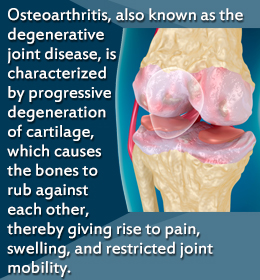Degenerative joint disease is a progressive disorder of the joints. This disease affects people in the older age group, and is a result of the wear and tear of the articular cartilage over time. This Buzzle article provides information on degenerative bone disease.

Degenerative bone disease is commonly known as degenerative osteoarthritis. There are over 100 types of arthritic conditions, of which osteoarthritis is the most common. More than 20 million Americans are affected by degenerative bone disorder.
What is Degenerative Disease?
Degenerative bone disease or degenerative arthritis is caused by wear and tear of the cartilage that covers the ends of the bones of the joints. It could affect the joints of hands, feet, spine, hips, and knees. The cartilage helps the bones glide over one another and acts as a shock absorber. With the wear and tear of the cartilage over the years, the bones begin to rub against each other, thereby causing pain, swelling, and loss of joint movement.
Causes of Degenerative Bone Disease
Most of the degenerative disorders do not have any known cause. The main factors causing degenerative arthritis are:
- Age: This disease affects people over the age of 45 years. There are exceptions where younger people or even children are affected by this disease.
- Sex: The degenerative joint disease is more common in women than men.
- Heredity: Certain pre-existing conditions like defective cartilage and joint deformity can lead to degenerative joint disease.
- Fractures: Accidental injuries or fractures of the joints may weaken the bones and lead to degenerative bone disorders.
- Other diseases: Rheumatoid arthritis, hemochromatosis, Paget's disease, and gout may affect the structure and functioning of the cartilage, leading to degenerative arthritis. Vitamin D deficiency, parathyroid disease, chronic kidney disease and senile osteoporosis may also cause degenerative bone disease.
Degenerative Joint Disease
Degenerative disorder may affect any joint in the body. The symptoms of degenerative arthritis include:
Spine: The facet joints of the spinal cord are affected in degenerative arthritis. The bones rub each other, thereby causing pain. The bones become weak and break down, affecting the nerves present in the area. The symptoms include:
- Back pain
- Stiffness of the spine, especially in the morning
- Tenderness in the shoulder
- Pain in the hips
- Numbness in the arms or legs due to pressure on the nerves
- Difficulty in bending and walking
- Deformity of the spine
Neck: This condition is also known as cervical spondylosis, cervical osteoarthritis, or degenerative joint disease of the neck. The seven vertebrae of the spine present in the neck are affected. This condition is very painful and mainly associated with muscle sprain, dislocation of the flexible disks or damage to the spinal cord. The symptoms of degenerative joint disorder include:
- Severe neck pain
- Headaches mainly in the back of the head
- Shoulder pain
- Stiffness of the neck and difficulty in turning or bending the neck sideways
- Pain or numbness in the arm.
- Clumsy hands
- Numbness in the legs and unsteadiness while walking. This is generally seen in elderly people.
- Coughing, sneezing, or any sudden activity may lead to increase in intensity of arm pain and shoulder pain.
Hands and Feet: When the condition affects the hands and feet, it becomes very painful to use the fingers, as well as toes. In fingers, the Herberden's nodes and Bouchard's nodes may be formed. These are hard bony enlargements that may or may not be painful. However, there is limitation in movement of fingers. Bunions may form in toes, making them red and swollen. Swelling, stiffness, limitation of movement, and pain are initial tell-tale signs of arthritis.
Hip: Degenerative hip arthritis commonly affects people over the age of 50 years. It is seen in obese people and is also a hereditary degenerative disorder. The common symptoms of degenerative joint disease of the hip are:
- Hip pain during physical activity
- The range of motion becomes limited
- Stiffness of the hip
- Limping when walking
Knees: This is one of the most common degenerative arthritis disorders. Chances of degenerative knee arthritis increase due to ligament damage, knee fractures, or trauma to the knee. The symptoms of degenerative bone disorder of the knee include:
- Pain during physical activities
- Limited range of motion
- Stiffness and swelling of the knee joint
- Deformity of the knee, like knock knees or bow legs
Treatment of Degenerative Bone Disease
Medical science has not yet come up with a concrete cure for treatment of degenerative bone disorder. The treatment options for degenerative arthritis mainly include the following:
- Medication for Degenerative Joint Disease:
Corticosteroids, and NSAIDs are prescribed to bring some relief to the pain in the joints. Glucocorticoid injections might be recommended for inflamed joints. Acetaminophen and aspirin are prescribed for mild pain without inflammation.
- Non-drug Treatments: Acupuncture, hot water therapy, ice packs, and herbal remedies might be recommended for temporary relief from pain.
- Weight Management: Obesity is the main cause that leads to degenerative arthritis. Losing weight and maintaining the correct height-weight ratio may help reduce the symptoms of degenerative bone disorder.
- Exercise: Exercises and physical therapy help maintain flexibility and decrease pain.
- Surgery: In extreme cases, the doctor may carry out spinal surgery to relieve chronic pain in the damaged joints.
The best way to alleviate the symptoms of degenerative bone disease is maintaining a healthy lifestyle and diet. Seek medical help, and follow your doctor's advice regarding drug therapy and lifestyle changes.


 Degenerative bone disease is commonly known as degenerative osteoarthritis. There are over 100 types of arthritic conditions, of which osteoarthritis is the most common. More than 20 million Americans are affected by degenerative bone disorder.
Degenerative bone disease is commonly known as degenerative osteoarthritis. There are over 100 types of arthritic conditions, of which osteoarthritis is the most common. More than 20 million Americans are affected by degenerative bone disorder.